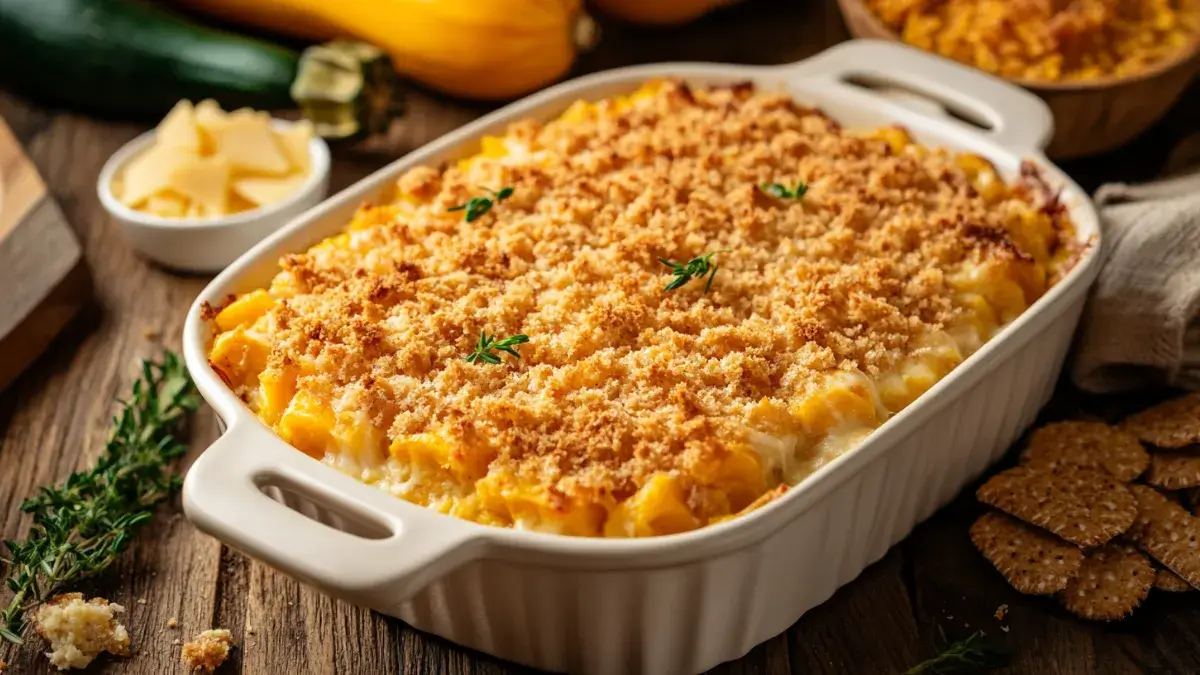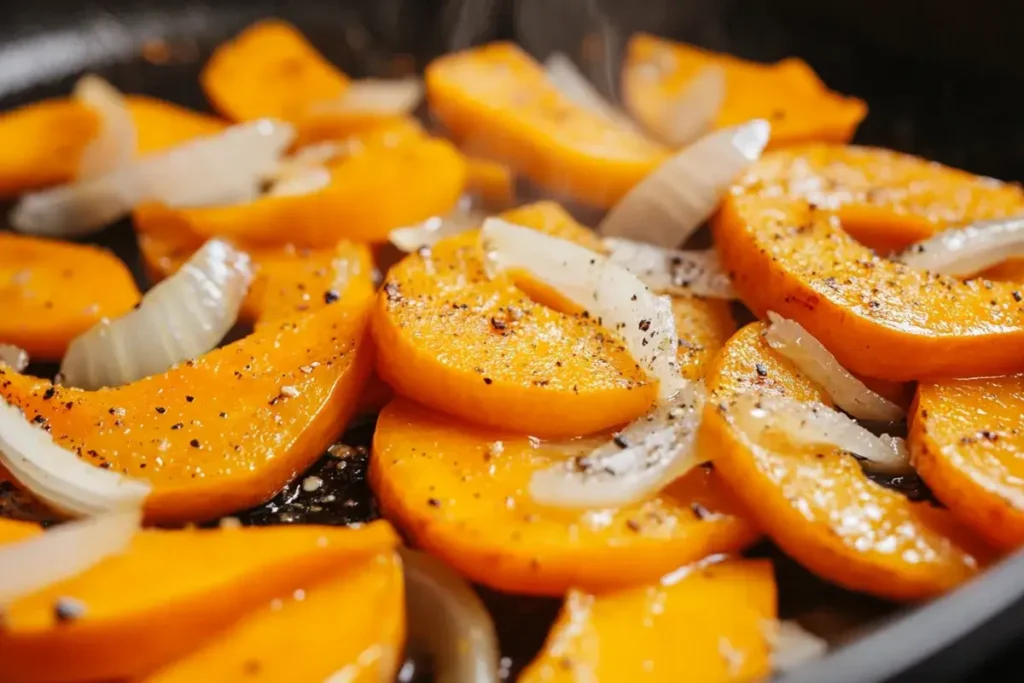Introduction to Squash Casserole
There’s something about a warm, cheesy squash casserole recipe that brings comfort to the table. Whether you’re gathered with family for a Sunday dinner or contributing a dish to a holiday potluck, squash casserole has long been a beloved staple of Southern cuisine. What makes this dish so popular is not just its creamy texture but also its versatility. It can easily be paired with other delicious side dishes for potlucks and gatherings or stand proudly as a hearty side.
The appeal of a good squash casserole recipe lies in its simplicity and rich flavor. Made with tender squash, a smooth, cheesy sauce, and a buttery, crunchy topping (often Ritz crackers or breadcrumbs), it’s a dish that balances texture and flavor perfectly. Whether you’re a seasoned cook or a kitchen newbie, this dish is easy to master, and it’s almost guaranteed to win over a crowd. In this article, we’ll dive deep into the classic squash casserole recipe, explore its origins, and show why it continues to be a must-have dish at family gatherings.
History of Squash Casserole
Squash casserole has been a fixture in Southern kitchens for generations, and its roots go back to the time when farmers used fresh squash from their gardens. In many ways, the dish is a symbol of resourcefulness—what better way to make use of an abundant summer crop than by baking it into a comforting casserole? Over time, the dish evolved, as cooks added various ingredients to enhance the flavors, such as onions, cheese, and, of course, the famous crispy cracker topping. For more creative ideas, explore these Thanksgiving side dishes to complement your squash casserole.
Traditionally, the squash casserole recipe was a basic dish of squash, butter, and perhaps a few seasonings. However, Southern cooks quickly began to get creative, adding a rich, cheesy base made from eggs, mayonnaise, or sour cream, and layering it with toppings that added both flavor and crunch. While the core ingredients remain the same, variations have emerged, such as using zucchini in place of yellow squash or experimenting with different cheeses. These tweaks have only increased the dish’s popularity, making it a favorite at potlucks and family reunions across the South.
Benefits of Cooking Squash Casserole
One of the biggest perks of making a squash casserole recipe is that it’s a fantastic way to use up all that fresh squash you might have sitting in your garden or that you picked up from the farmer’s market. Squash is abundant in the summer months, and this dish allows you to enjoy it in a warm, flavorful way that makes it suitable for any occasion.
Preparing this dish couldn’t be easier, which is why it’s a go-to for many home cooks. With just a handful of ingredients—squash, cheese, crackers, and a few seasonings—you can have a delicious casserole on the table in under an hour. It’s also an ideal choice for gatherings, from weeknight family dinners to holiday feasts. When you bring a squash casserole to a potluck, it’s almost guaranteed that your dish will be one of the first to disappear! For more ideas, try serving it alongside other crowd-pleasers like taco casserole at your next gathering.
Another reason to love this recipe is its versatility. The casserole can be served as a vegetarian main dish, especially when paired with this easy cornbread casserole and a salad. For those who enjoy customizing their recipes, you can switch up the cheese, add in vegetables like bell peppers, or even sprinkle in some herbs to match the season. No matter how you prepare it, squash casserole is a dish that’s guaranteed to satisfy.
Recipe Breakdown
Ingredients for Squash Casserole
To make the perfect squash casserole recipe, you’ll need a few simple and affordable ingredients that come together to create a dish rich in flavor and texture. Here’s what you’ll need:
Essential Ingredients:
- Yellow squash: About 4-5 medium-sized yellow squash (roughly 6 cups, sliced). You can also use zucchini or a mix of both for a slight variation.
- Onion: 1 medium yellow onion, diced. The sweetness of cooked onions enhances the flavor of the squash.
- Cheddar cheese: 1 cup of sharp cheddar cheese, grated. This adds that essential cheesy goodness. You can also use other cheeses like Gruyere or Colby Jack for a different flavor profile.
- Eggs: 2 large eggs, lightly beaten. These help bind the ingredients together while contributing to the creamy texture.
- Mayonnaise: ½ cup. This adds richness to the casserole without making it watery. You can substitute with Greek yogurt if you want a lighter option.
- Sour cream: ½ cup. This helps create the creamy base that holds the casserole together.
- Ritz crackers: About 1 cup of crushed crackers. These are used for the crunchy topping that gives the casserole its signature texture. You can also use seasoned panko breadcrumbs if preferred.
- Butter: 4 tablespoons, melted. This will be mixed with the crackers for the topping.
- Salt and pepper: To taste, to season both the squash and the casserole mixture.
Optional Variations:
- Zucchini: Substitute some or all of the squash with zucchini for a slight variation in flavor.
- Herbs: Add a tablespoon of fresh thyme or parsley to give a bit of herbal freshness to the casserole.
- Parmesan cheese: Sprinkle some grated Parmesan into the cracker topping for an extra layer of savory flavor.
Tip:
Using fresh, high-quality ingredients is key to the success of this squash casserole recipe. Fresh squash and onions will ensure the dish has the best flavor, and grating your own cheese (instead of using pre-shredded) will give the casserole a smoother, creamier texture.
Step-by-Step Instructions
Now that you have your ingredients ready, let’s walk through how to make this comforting, crowd-pleasing squash casserole recipe. It’s simple enough for a weeknight dinner, but special enough for a holiday gathering.
Preparing the Squash
- Slice the squash: Start by slicing your yellow squash into thin, even rounds (about ¼ inch thick). If you’re using zucchini as well, slice it similarly.
- Sauté the squash: In a large skillet, melt 2 tablespoons of butter over medium heat. Add the sliced squash and diced onions, and sauté for about 10 minutes, stirring occasionally, until the squash is just tender and most of the liquid has evaporated.
- Tip: Be careful not to overcook the squash at this stage, as it will continue cooking in the oven.
- Tip: Be careful not to overcook the squash at this stage, as it will continue cooking in the oven.
- Drain the squash: Transfer the cooked squash and onions to a colander to drain any excess water. This step is crucial to avoid a watery casserole. Let it cool for a few minutes while you prepare the creamy base.
Mixing the Creamy Base
- Prepare the cheese mixture: In a large mixing bowl, whisk together the eggs, mayonnaise, sour cream, and grated cheddar cheese. Add a pinch of salt and pepper to taste.
- Combine with the squash: Once the squash has cooled slightly, fold it gently into the creamy mixture. Be sure to stir slowly to avoid breaking up the squash slices.
Layering the Casserole
- Grease the baking dish: Lightly grease an 8×8-inch baking dish with butter or cooking spray to prevent sticking.
- Layer the casserole: Pour the squash and creamy mixture into the prepared baking dish. Spread it out evenly with a spatula to ensure every bite has that perfect squash-to-cream ratio.
Preparing the Crunchy Topping
- Crush the crackers: In a small bowl, combine the crushed Ritz crackers (or panko breadcrumbs) with the remaining 2 tablespoons of melted butter. Stir until the mixture is well coated.
- Add the topping: Sprinkle the buttered cracker mixture evenly over the top of the casserole.
- Optional: If you want to add an extra layer of flavor, sprinkle some grated Parmesan cheese over the cracker topping before baking.

Baking the Casserole
- Preheat the oven: While you’re preparing the casserole, preheat your oven to 350°F (175°C).
- Bake: Place the casserole in the preheated oven and bake for about 25-30 minutes, or until the top is golden brown and the casserole is bubbling around the edges.
- Tip: For an extra-crispy topping, you can broil the casserole for the last 2-3 minutes of baking. Just be sure to keep an eye on it to avoid burning the top.
- Let it cool: Once it’s done, remove the casserole from the oven and let it sit for 5-10 minutes before serving. This helps the flavors settle and makes it easier to slice.
Variations and Expert Tips
Different Variations of Squash Casserole
One of the beauties of a squash casserole recipe is its flexibility. Whether you like to stick to the classics or try something new, there’s a version of squash casserole for everyone. Here are a few ways to switch things up:
Classic vs. Modern Variations
The traditional squash casserole recipe calls for yellow squash, onions, cheddar cheese, and a buttery cracker topping. But don’t hesitate to experiment with more modern flavors:
- Bell Peppers: Adding diced bell peppers (especially red or yellow) introduces a pop of color and sweetness that complements the squash.
- Alternative Cheeses: For a more gourmet take, swap out the cheddar with Gruyere or Swiss cheese. These cheeses melt beautifully and offer a nutty, savory depth that elevates the dish.
- Breadcrumb Topping: While Ritz crackers are a favorite, you can also use seasoned panko breadcrumbs for a lighter, crunchier topping.
Vegetarian-Friendly Substitutions
If you’re looking to make this casserole a bit healthier or vegetarian-friendly without losing its signature creaminess:
- Swap Mayonnaise for Greek Yogurt: Greek yogurt is a great substitute for mayonnaise, bringing a tangy flavor and a bit of extra creaminess without altering the texture.
- Add Mushrooms: Incorporating sautéed mushrooms can give the dish an earthy richness and a little more texture. This is especially satisfying if you’re serving it as a vegetarian main dish.
Seasonal and Holiday Variations
Squash casserole doesn’t have to be just a summer dish. You can adapt it to the season or holiday:
- Squash and Zucchini Combo: Use both yellow squash and zucchini for added color and flavor.
- Holiday Touches: For a festive twist, add diced pimientos to the casserole. Their red color and subtle sweetness make this a perfect side for Thanksgiving or Christmas gatherings.
No matter how you tweak your squash casserole recipe, the key is balancing flavors and textures to create a dish that’s both comforting and exciting.
Expert Tips for the Perfect Squash Casserole
Mastering a squash casserole recipe isn’t difficult, but a few expert tips can make all the difference in taking your casserole from good to great. Here are some tried-and-true tricks:
Preventing a Watery Casserole
One of the most common issues with squash casseroles is excess water, which can make the dish soggy. Here’s how to prevent that:
- Drain the Squash Thoroughly: After sautéing or boiling the squash, let it drain in a colander for a few minutes to remove as much moisture as possible.
- Avoid Overcooking Before Baking: Squash releases water as it cooks, so be sure to cook it just until tender when sautéing. It will continue cooking in the oven, so undercooking it slightly can help prevent wateriness.
Achieving the Perfect Crispy Topping
The topping is what takes a squash casserole from basic to extraordinary. Here’s how to make sure your casserole has the perfect crunch:
- Use Buttered Crackers: Mix melted butter with crushed Ritz crackers or breadcrumbs to achieve a golden, crispy topping.
- Add Parmesan: For an extra layer of flavor, sprinkle some grated Parmesan cheese on top of the cracker mixture before baking.
Storing and Reheating
Squash casserole can be made ahead of time or stored for later use, but you’ll want to do it right to maintain its flavor and texture:
- Refrigerate Leftovers: Store leftover casserole in an airtight container in the fridge for up to 3 days. Reheat it in the oven to maintain the crispy topping.
- Freezing the Casserole: If freezing, do so before adding the cracker topping. Once thawed, add the topping and bake as directed.
Serving Suggestions for Squash Casserole
Squash casserole is the ultimate comfort food, and it pairs beautifully with a variety of main dishes and sides. Here are some serving ideas to round out your meal:
Main Dish Pairings
- Fried Chicken: The creamy, cheesy squash casserole pairs perfectly with crispy, juicy fried chicken. It’s a classic Southern combination that never fails to satisfy.
- Grilled Pork Chops: The savory flavors of grilled or roasted pork chops are a great complement to the mild sweetness of the casserole.
- Vegetarian Main: If you’re going meat-free, serve the casserole as a main dish alongside a warm, buttery skillet of cornbread. The textures and flavors are perfectly balanced for a hearty vegetarian meal.
Side Dish Pairings
To complete your meal, consider serving your squash casserole with one of these sides:
- Green Beans: A simple side of steamed or roasted green beans adds a fresh, crisp contrast to the richness of the casserole.
- Mashed Potatoes: For a truly indulgent meal, serve your squash casserole alongside creamy mashed potatoes. The combination of two comforting sides is sure to be a crowd-pleaser.
With its creamy texture, crunchy topping, and versatile flavors, squash casserole shines whether it’s the star of the meal or the perfect sidekick.
Conclusion and Extras
Common Mistakes to Avoid
Even the best squash casserole recipe can go wrong with a few common missteps. Here are the mistakes you’ll want to steer clear of to ensure your casserole turns out perfectly every time:
- Overcooking the squash during preparation: When sautéing or boiling the squash, it’s important to cook it just until it’s tender. Overcooking will cause the squash to release too much moisture during baking, resulting in a soggy casserole.
- Not draining excess liquid properly: Squash naturally holds a lot of water, and if it isn’t drained well, your casserole will end up watery. Always drain the cooked squash thoroughly in a colander before mixing it with other ingredients.
- Using pre-shredded cheese: While convenient, pre-shredded cheese often contains anti-caking agents that prevent it from melting smoothly. Always use freshly grated cheese for a creamier, richer texture in your casserole.
Frequently Asked Questions
Here are answers to some of the most common questions about making the perfect squash casserole recipe:
Can squash casserole be made ahead?
Yes! Squash casserole is an excellent make-ahead dish. You can prepare the casserole up to the point of adding the topping, cover it tightly with plastic wrap or foil, and store it in the refrigerator for up to 24 hours. When you’re ready to bake, add the topping and proceed with the baking instructions.
Can you freeze squash casserole?
Yes, squash casserole can be frozen. However, it’s best to freeze it before adding the topping. Assemble the casserole, let it cool completely, then wrap it tightly in plastic wrap and foil before freezing. When you’re ready to bake, thaw it overnight in the fridge, add the cracker topping, and bake as directed.
Why is my squash casserole watery?
A watery casserole is usually the result of not draining the cooked squash thoroughly or overcooking the squash. To avoid this, drain the squash well after sautéing and slightly undercook the squash before mixing it into the casserole.
What can I use instead of Ritz crackers?
If you don’t have Ritz crackers on hand, you can substitute with panko breadcrumbs, crushed saltine crackers, or even cornflakes for a crunchy topping. Season the alternative topping with a bit of melted butter to achieve a similar texture.
Can you make squash casserole without eggs?
Yes, you can make a squash casserole without eggs, though the texture may be slightly different. The eggs help bind the casserole, so without them, it may be a bit looser. If you want a firmer consistency, you can add a bit more sour cream or cheese.
Conclusion
In conclusion, a squash casserole recipe is a simple, comforting dish that brings people together, whether for a holiday gathering or a casual weeknight meal. With its creamy, cheesy base and crunchy topping, it’s a versatile dish that can be customized to your liking. Don’t hesitate to experiment with variations like zucchini, different cheeses, or unique toppings to make it your own.
I hope you’re excited to try this recipe at home! When you do, share your creations on social media or drop a comment below. I’d love to hear how you made this classic dish your own. Happy cooking!


